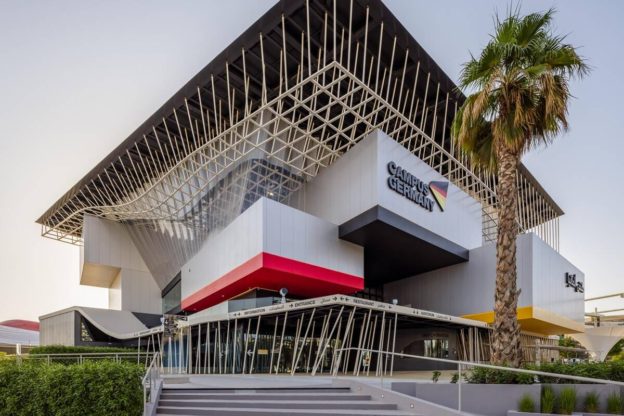Everyone who has visited has been all praises for the German display at the Expo 2020.
Sustainability in Germany: Germany is known for its best-in-class technology, and in the Bloomberg Innovation Index 2020, the country was named the most technologically advanced. It only makes sense then that Germany would lead the way towards sustainability and try to find solutions to the problem that the entire world faces. This is what the German pavilion at Dubai Expo 2020 focuses on, and it has been all the rage. Everyone who has visited has been all praises for the German display at the Expo 2020, and due to the word of mouth, Financial Express Online also visited the pavilion and the solutions and innovations were par excellence, we believe.
German Pavilion at Expo 2020: What makes it special
Before we jump straight into the solutions, the concept of the pavilion does deserve to be mentioned here. The pavilion is located in the Sustainability District of the Expo 2020 site, which is one of the three key districts and sub-themes of the six-month exhibition – Opportunity, Mobility and Sustainability. The pavilion has been named Campus Germany, because it aims to convey that sustainability is a subject that requires analysis, research, practice as well as development. It has been defined as a campus to promote knowledge, research, dialogue as well as human interaction.
 Electric planes are the future of transportation, according to Germany. (Image: Bulbul Dhawan/Financial Express Online)
Electric planes are the future of transportation, according to Germany. (Image: Bulbul Dhawan/Financial Express Online)The pavilion has been set up like a vertical campus, with three cubes (representing three different aspects in the study of sustainability) placed in a more vertical design rather than being spread out like a campus.
Germany has created the entire pavilion much like a campus, dividing it between theory and practical. The entire pavilion is interactive, and it starts from the “induction” of the visitors and ends at the “graduation hall”. Before “induction”, each visitor is given a “name badge” which is a technology enabled badge. To make this, the pavilion authorities collect the name, city and language of each visitor and feed it into this badge. The pavilion has many interactive aspects, some of which need to get the name and language information of the visitor to interact with them, and some of which identify the visitor’s country to display relevant statistics.
The campus has three labs which focus on theory and problems related to the labs themes – Energy Lab, Future City Lab and Biodiversity Lab, and then an adjoining terrace where visitors can see the solutions that Germany has proposed for those problems. Many of these solutions are explained with the help of interactive activities, most of which need the participation of many visitors – just like in a campus education and its group projects.
Sustainability: Germany’s solution
The German Pavilion not only showcases sustainable solutions that the country’s companies and organisations have come up with, but even its set up at the Expo 2020 is as sustainable as possible. Since the Expo site needs to be vacated by some countries, Germany’s pavilion will be dismantled post March 31, 2022. However, the pavilion has been built to ensure that almost all of its components can be reused for other projects. All of the material that has been used in the building is lightweight, and the use of concrete and glass has been kept to a minimum. Instead, the pavilion used ETFE films in the facade, which can be cleaned and reused for other projects once the display is dismantled.
 Are modular farms the way forward? (Image: Bulbul Dhawan/Financial Express Online)
Are modular farms the way forward? (Image: Bulbul Dhawan/Financial Express Online)In fact, the exhibition set up in the Future City Terrace has been developed using material made of recycled waste of the insulation industry. The material, as per the country, is completely recyclable, it does not emit concerning amounts of chemical substances and it is also formaldehyde-free.
The country’s pavilion showcases innovations of about 20 businesses, research centres and universities in the field of sustainability, and the solutions seem promising.
In the Energy Lab, the pavilion demonstrates how they are looking at generating energy from ocean waves with the help of wave power plants, while another solution that has been put forth is storage of excess energy for a long period of time using limestone.
The Future City Lab looks at what cities of a sustainable future should look like, and here, the country chose to display the work of its researchers in developing bacteria that are capable of absorbing plastic from fossil resources and converting it into compostable and reusable bioplastic. Apart from that, Germany has also displayed a new type of elevator that it is working on which will be able to travel horizontally and vertically – talk about Charlie and the Chocolate Factory coming to life! The elevator is also proposed to have smart control.
 Future elevators can travel vertically and horizontally! (Image: Bulbul Dhawan/Financial Express Online)
Future elevators can travel vertically and horizontally! (Image: Bulbul Dhawan/Financial Express Online)They have also put on display a model of an electric mini plane that can ferry a few passengers at a time in a more sustainable way of travel as compared to the current fuel-absorbing aircrafts. Apart from this, what is also on display is a model of farming in the modern city, where modular farms in a climate-resilient, remote-controlled building can lead to a wide selection of crops being grown year-round, to help in cutting down the food supply chain.
In terms of biodiversity, the country is looking for alternatives to the use of pesticides since such substances are causing the loss of biodiversity. Instead, the Laser Centre Hannover is developing a system which uses lasers to optically detect weeds in crops.
https://www.financialexpress.com/lifestyle/travel-tourism/towards-a-sustainable-future-germanys-pavilion-at-dubai-expo-2020-shows-how-it-is-leading-the-way/2383845/







